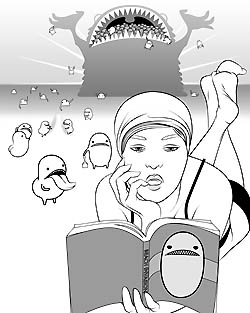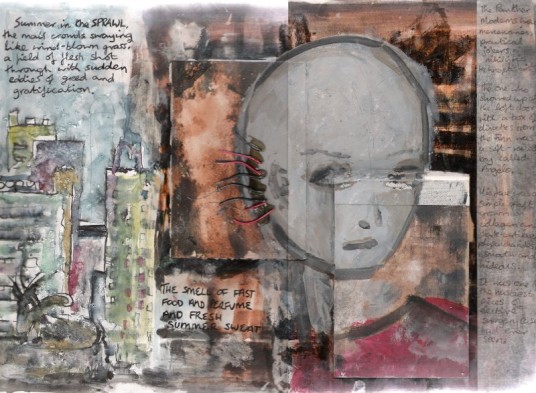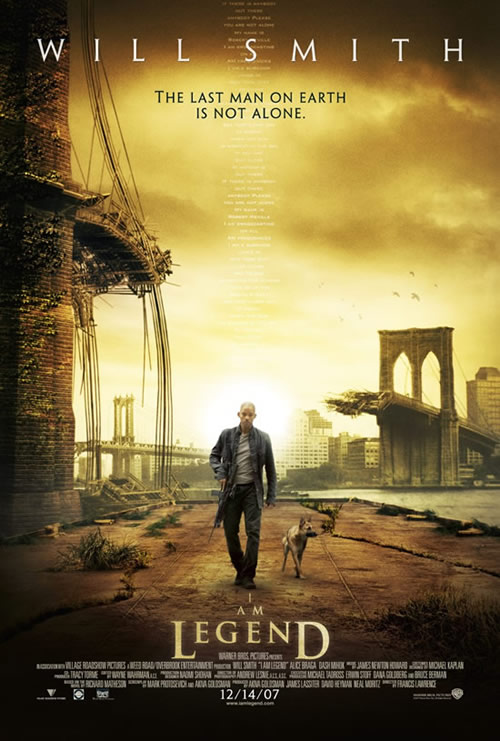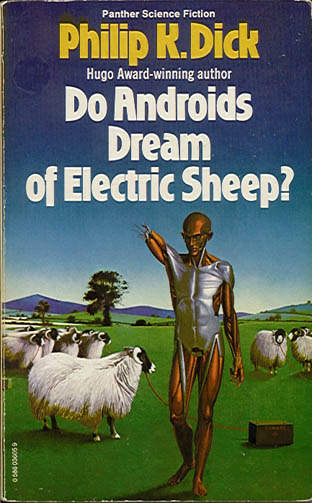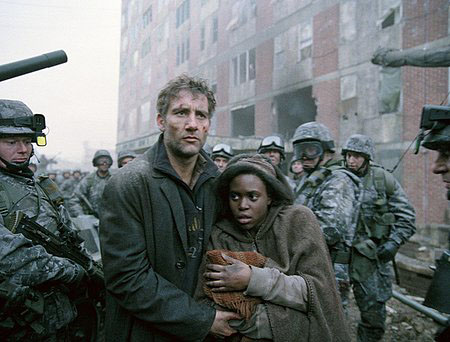|
Irvine Valley College: Online Literature Study of the School of Humanities and Languages Literature 110 - Popular Literature Spring 2013 - Ticket #62740 // Marjorie Coverley Luesebrink, MFA, Instructor
Unit 8b: Science Fiction and The Future Neuromancer, William Gibson
Reassuring Plot Despite the relentless tumble of contemporary objects - computers, artificial body parts, inventive software, hard-edge urban landscapes, the plot line of Neuromancer is nearly classic in its evocation of familiar literary narratives and even popular genre tricks. We have a Coming-of-Age for Case, who is actually very young and does not really "grow up" until he makes that key mistake and then has to figure out a different life.
Collage for *Neuromancer* by Hannah Jane Beresford Mixed in with the Coming-of-Age is the journey to find the Mentor - the young man needs to make a pilgrimage on behalf of a significant leader of the older generation. And, as in all coming-of-age stories, we have a love experience. Traditionally, stories which have a female protagonist end with the couple together. Frequently, though, coming-of-age stories with a male protagonist end with the girl leaving, or dying, or something. Presumably, the experience of coming-of-age does not end with a secure partnership for young men. [I think this is particularly interesting because the protagonist of Gibson's most recent novel, Pattern Recognition, is a female. Cayce is her name - pronounced, significantly enough, "case." So, essentially, the two characters have the same name, pronounced the same, spelled differently!) At the end of Pattern Recognition, Cayce gets her man, and she is glad to be in love with him in Paris and leave technology behind - at least for a while!] And, of course, the story depends for its excitement on a gripping tale of murder and international crime - wrapped in a puzzling mystery.
an experiment in pattern recognition *Pattern Recognition* by William Gibson was published in 2003. Set in August and September 2002, the story follows Cayce Pollard, a 32-year-old marketing consultant who has a psychological sensitivity to corporate symbols. The action takes place in London, Tokyo, and Moscow as Cayce judges the effectiveness of a proposed corporate symbol and is hired to seek the creators of film clips anonymously posted to the internet. The novel's central theme involves the examination of the human desire to detect patterns or meaning and the risks of finding patterns in meaningless data.
The Last Man on Earth is a 1964 Italian horror/science fiction film based upon the Richard Matheson novel I Am Legend. The film was directed by Ubaldo Ragona and Sidney Salkow, and stars Vincent Price. The script was written in part by Matheson, but he was dissatisfied with the result and was therefore credited as "Logan Swanson". William Leicester, Furio M. Monetti, and Ubaldo Ragona were the other writers. and a new version: Will Smith is the last man on earth. The movie is directed by Ridley Scott. The last take on this story (Richard Matheson's post-apocalyptic I Am Legend), The Omega Man. In this story, a man finds himself in a world that is stricken with a plague that turns human beings into vampires. The hero spends his days killing the vampires and burning their bodies. Finally, he finds a woman who seems to be immune, as he is, to the virus. But she is not, and her people kill him in the end. Note, here, the interesting crossover between Horror vampires and Science Fiction "last Man" scenarios! Patterned Structure The structure of the novel is, for the most part, chronological. We have a series of scenes of "rising action" culminating in a climax and followed by an ambiguous denouement. While there are important "flashbacks" to backstory material, the main momentum of the structure follows a classic Aristotelian architecture. But Neuromancer is also anchored by place. The novel starts in Chiba City and moves to Istanbul, Freeside, Paris, and through the "Matrix." This use of place as a marker for the stages of the rising action, and also as a way to emphasize various cultural artifacts, is important to this novel and to Cyberpunk in general. Because the plot depends on the reader being able to construct a world that exists both in materiality and in cyberspace, the sensory placement and description of real cities on the face of earth acts as a kind of grid, or matrix if you will, for the reader to build the cyber connections. The patterned structure of the "landscape" - both geographically real and imagined - is key to being able to track the plot. However, the plot structure itself owes a great deal to the "Western" or "Adventure" novels that we have looked at previously - and also to the "hero" challenges that we find in some fantasy novels. Case is confronted with a challenge. He "rides out of town" (ie. out of the real world) into the cyber world to do battle with the enemy. They battle back and forth. A woman is involved. There is the possibility of "the capture narrative." Case wins a temporary victory. So, even in this most sophisticated of Sci-Fi stories, we still have an overall pattern that is familiar to readers of Sci-Fi. Part of our Lecture this week is to read the study guide that Professor Paul Brians of Washington State University has Online for the public. His Chapter-by-Chapter analysis is terrific, and he explains much of the unfamiliar terminology of each section. <http://www.webring.org/l/rd?ring=williamg;id=8;url=http%3A%2F%2Fpublic%2Ewsu%2Eedu%2F%7Ebrians%2Fscience_fiction%2Fneuromancer%2Ehtml> Please use the questions that Professor Brians has asked as prompts for your Discussion this week! Part of the beauty of Technology is sharing information between colleges and colleagues! Notes by Paul Brians, Department of English, Washington State University, Pullman 99164-5020
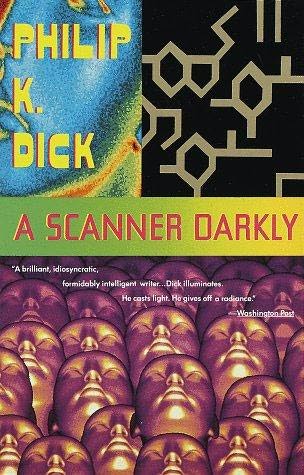
Bookcover for Philip K. Dick's *A Scanner Darkly* Clear-cut Value System One particularly interesting aspect of the Sci-Fi genre is the question of value systems that apply. In many Sci-Fi novels - in fact in whole series of novels - the main theme is often the way in which the modern world has been corrupted by technology [that is, while technology is at the center of the story, it is in no way admired or endorsed]. If the world could go back to a simpler way of life, these novels seem to say, we would be so much better off! One of the most popular modern writers that follows this theme is Philip K. Dick (1928 - 1982). His novels and stories have been made into many popular films, including - Blade Runner, Total Recall, A Scanner Darkly and Minority Report.
Bookcover for Philip K. Dick's *Do Androids Dream of Electronic Sheep* - the book that gave rise to the movie *Blade Runner* In the storylines for these novels, stories, and films, characters are often seen giving up their agency for the conveniences of technology - and thus losing control of their own freedom and destiny. While this kind of situation is much like *Neuromancer* in the sense that Case has traded part of his humanity for the benefits of technology, the value systems are quite different. Philip K. Dick's stories seem to suggest that the future is a choice. In Gibson, the technological world is firmly in control, and the characters must adapt to it or suffer the consequences. Thus, we tend to see two different kinds of value systems depending upon the time period that a Sci-Fi work was written and upon the sensibility of the author. If the author is harking back to better and simpler times, and uses science and technology to show what can happen in a dystopic [a Dystopia is, of course, the opposite of a Utopia - a horrible society rather than an ideal one] future, then we tend to see value systems that are based on traditional values of human sympathy, kindness, honesty, and love. Ray Bradbury is among the more optimistic of the Sci-Fi writers - even when his characters operate in a dystopia, they exhibit a courage about values and meaning in life. In general, the traditional values are under assault, but the characters fight valiantly to protect them.
Movie Poster for Bradbury's *Fahrenheit 451*
On the other hand, if the novel moves us into a future that is the "given" - that is, no going back - then we tend to see value systems that are more in keeping with a future (whether pleasant or unpleasant) that requires a new kind of behavior.
Children of Men is a 2006 dystopian science fiction film co-written and directed by Alfonso Cuarón. It was loosely adapted from P.D. James’ 1992 novel The Children of Men.
Case is one of the creatures of the latter kind of world. He is wary of love, very much a loner, secretive, and untethered. His loyalties are entirely local - to himself and a few close friends (not community, not country, not religion, and not humanity in general). His ethical world is shockingly pragmatic. He does what is right in front of him that will keep him alive. And not much more - unless the circumstances are unusual. And, most important, his attachment to "this" world is not much stronger than his attachment to the "matrix" web of cyberspace. Both worlds claim his attention and his efforts. To a great extent, the value systems in Sci-Fi novels are linked to the quality of the world that the characters inhabit. Case lives in a hard-edged future - one that gives very little room for error or diversion; it is marked with human misery, poverty, oppression, violence, disease, and pollution. Even when people are having "fun" and being "entertained" - the specter of violence and repression is always present. Thus, it makes sense that Case would be a careful and tense being, focused on his ability to navigate the dystopia he finds all around him. In our discussions for this unit, we can look closely at the value systems for Case and the characters in *Neuromancer.*
*The Handmaid's Tale* by Margaret Atwood depicts a modern Dystopia for Women
Continue to next page - to Unit 8c
Science Fiction: William Gibson: <http://www.williamgibsonbooks.com/index.asp> Philip K. Dick: <http://en.wikipedia.org/wiki/Philip_K._Dick>; <http://www.wired.com/wired/archive/11.12/philip_pr.html> Jules Verne: <http://epguides.com/djk/JulesVerne/works.shtml> Ursula K. Le Guin has a fantastic Web Site! Ray Bradbury is a long-time favorite. Although best known for The Martian Chronicles, Bradbury has been writing wonderful books for decades! Actually, should we want to talk about Categories overlapping, we have the perfect example with Science Fiction - one of the reasons for this is that much "real literature" is science fiction in content - and many of the fantasy and mystery genre tropes can also be seen as SciFi. Take a look at this list from Wikipedia of top SciFi Authors: this list is a treasure in itself! If you are having trouble finding an author for the Research Paper, it is a good place to start looking!
Marjorie Coverley Luesebrink: write to me with questions!
Marjorie Coverley Luesebrink, MFA, your Instructor, is a Professor of English in the School of Humanities and Languages, Irvine Valley College, Irvine, California. See Online writing at Home Page. |
| MENUBAR: About Your Class // Class Syllabus // Lecture Notes // Reading List // Recommended Reading // Assignments // Grading Policies // Contact Your Instructor // Announcements // Discussion |
